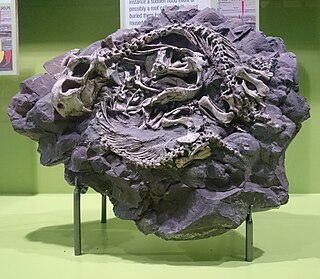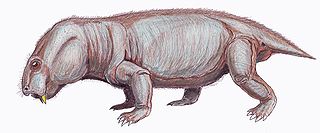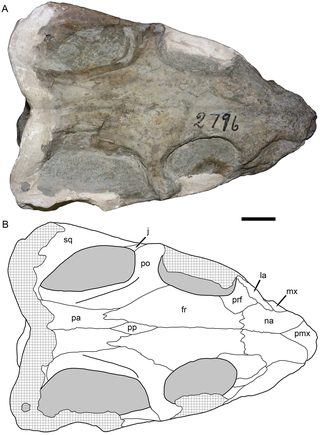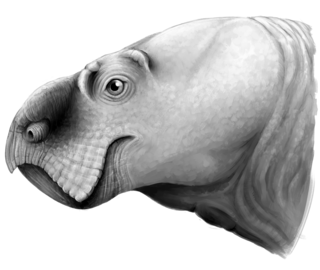Related Research Articles

Dicynodontia is an extinct clade of anomodonts, an extinct type of non-mammalian therapsid. Dicynodonts were herbivores that typically bore a pair of tusks, hence their name, which means 'two dog tooth'. Members of the group possessed a horny, typically toothless beak, unique amongst all synapsids. Dicynodonts first appeared in Southern Pangaea during the mid-Permian, ca. 270–260 million years ago, and became globally distributed and the dominant herbivorous animals in the Late Permian, ca. 260–252 Mya. They were devastated by the end-Permian Extinction that wiped out most other therapsids ca. 252 Mya. They rebounded during the Triassic but died out towards the end of that period. They were the most successful and diverse of the non-mammalian therapsids, with over 70 genera known, varying from rat-sized burrowers to elephant-sized browsers.

"Dromasaurs" are an artificial grouping of small anomodont therapsids from the Middle and Late Permian of South Africa. They represent either a paraphyletic grade or a polyphyletic grouping of small non-dicynodont basal anomodonts rather than a clade, and as such are considered an invalid group today. "Dromasaurs" were historically united by their superficially similar appearances that were unlike other known anomodonts. They are all small in size with slender limbs and long tails, and have short skulls with very large eye sockets. "Dromasauria" traditionally includes three genera, all from the Karoo Supergroup of South Africa: Galepus, Galechirus, and Galeops. These genera have sometimes been divided into two subgroups, the monotypic family Galeopidae and the Galechiridae for Galechiris and Galepus.

Stahleckeria is an extinct genus of Middle Triassic (Ladinian) dicynodonts. It lived about 240 million years ago in what is now Brazil and Namibia. As a member of the group Kannemeyeriiformes, it was similar to the genus Kannemeyeria. The genus is known from the type species Stahleckeria potens, which was first collected from the Ladinian-age Santa Maria Formation in the Paleorrota fossil site of Brazil. Stahleckeria was named in honor of Rudolf Stahlecker, who discovered the first specimens during a 1935 expedition led by paleontologist Friedrich von Huene to the Chiniquá fossil site.

Eodicynodon is an extinct genus of dicynodont therapsids, a highly diverse group of herbivorous synapsids that were widespread during the middle-late Permian and early Triassic. As its name suggests, Eodicynodon is the oldest and most primitive dicynodont yet identified, ranging from the middle to late Permian and possessing a mix of ancestral Anomodont/therapsid features and derived dicynodont synapomorphies.

Endothiodon is an extinct genus of large dicynodont from the Late Permian. Like other dicynodonts, Endothiodon was an herbivore, but it lacked the two tusks that characterized most other dicynodonts. The anterior portion of the upper and lower jaw are curved upward, creating a distinct beak that is thought to have allowed them to be specialized grazers.

Anomocephalus is an extinct genus of primitive anomodonts and belongs to the clade Anomocephaloidea. The name is said to be derived from the Greek word anomos meaning lawless and cephalos meaning head. The proper word for head in Greek is however κεφαλή (kephalē). It is primitive in that it retains a complete set of teeth in both jaws, in contrast to its descendants, the dicynodonts, whose dentition is reduced to only a single pair of tusks, with their jaws covered by a horny beak similar to that of a modern tortoise. However, they are in no way closely related.

Myosaurus is a genus of Anomodontia in the order Therapsida. They are also classified as Dicynodontia, which is a subclade of Anomodontia. The Mysosaurus was a small, herbivorous reptile that existed around the early Triassic period. All of the fossils found of this species were found in Antarctica and South Africa. Compared to other fossils found from species that existed during this time, the Myosaurus is not common in the fossil record. This is due to a shortage of discovered fossils that possess characteristics unique to the Myosaurus. Notably, under 130 fossil fragments have been found that have been classified as Myosauridae, and almost all have been skulls. These skulls can be classified as Myosaurus because this species, unlike other dicynodonts, do not possess tusks or postfrontal teeth. The only species identified in the family Myosauridae is the Myosaurus Gracilis, or M. Gracilis. It should be recognized that the Myosaurus is almost always referred to as the M. Gracilis in scientific research.
Angonisaurus is an extinct genus of kannemeyeriiform dicynodont from the Middle Triassic of Africa between 247 and 242 million years ago. Only one species, Angonisaurus cruickshanki has been assigned to this genus. This genus is thought to have been widely spread but rare in southern Gondwana. Though few in number, the fossil record of Angonisaurus cruickshanki contains multiple specimens giving it a measurable stratigraphic range. Sexually dimorphic features are found in Angonisaurus which include presence or absence of tusks and difference is size and robustness of the temporal arch and the rostral.

Dicynodontoides is a genus of small to medium-bodied, herbivorous, emydopoid dicynodonts from the Late Permian. The name Dicynodontoides references its “dicynodont-like” appearance due to the caniniform tusks featured by most members of this infraorder. Kingoria, a junior synonym, has been used more widely in the literature than the more obscure Dicynodontoides, which is similar-sounding to another distantly related genus of dicynodont, Dicynodon. Two species are recognized: D. recurvidens from South Africa, and D. nowacki from Tanzania.

Odontocyclops is an extinct genus of Dicynodonts that lived in the Late Permian. Dicynodonts are believed to be the first major assemblage of terrestrial herbivores. Fossils of Odontocyclops have been found in the Karoo Basin of South Africa and the Luangwa Valley of Zambia. The phylogenetic classification of Odontocyclops has been long under debate, but most current research places them as their own genus of Dicynodonts and being very closely related to Rhachiocephalus and Oudenodon.
Synostocephalus is an extinct genus of dicynodont from late Permian South Africa and Zimbabwe. It is possibly a member of Eumantellidae.

Ulemica is an extinct genus of venyukovioid therapsids, a type of anomodont related to dicynodonts. It lived during the Middle Permian period in what is now Russia, and is known from the Isheevo assemblage of the Amanakskaya Formation. The type species, U. invisa, was originally placed in the genus Venyukovia by Russian palaeontologist Ivan Efremov in 1940. It was later given its own genus Ulemica in 1996 by Mikhaïl Ivakhnenko, who also named a second species U. efremovi. Efremov had originally intended to name the fossils of U. invisa as 'Myctosuchus invisus', however, he later recognised their similarity to Venyukovia and chose to assign the Isheevo material to this genus and leaving 'Myctosuchus' a nomen nudum.

Lystrosauridae is a family of dicynodont therapsids from the Permian and Triassic time periods. It includes two genera, Lystrosaurus and Kwazulusaurus. Kwazulusaurus includes a single species, K. shakai, from the Late Permian of South Africa and Lystrosaurus includes many species from the Late Permian and Early Triassic of South Africa, India, and Antarctica.

Venyukovioidea is an infraorder of anomodont therapsids related to dicynodonts from the Permian of Russia. They have also been known as 'Venjukovioidea', as well as by the similar names 'Venyukoviamorpha' or 'Venjukoviamorpha' in literature. This in part owes to a misspelling by Russian palaeontologist Ivan Efremov in 1940 when he mistakenly spelt Venyukovia, the namesake of the group, with a 'j' instead of a 'y', which permeated through subsequent therapsid literature before the mistake was caught and corrected. The order Ulemicia has also been coined for a similar taxonomic concept in Russian scientific literature, which notably excludes Suminia and Parasuminia.

Chainosauria is a large and speciose clade of anomodont therapsid that includes the highly diverse dicynodonts and a small number of closely related basal genera —although the total composition and taxonomic scope of Chainosauria is in flux. Chainosauria was named in 1923 to group together the dicynodonts and their close relatives, namely three small anomodont genera from South Africa that made up the now defunct group 'Dromasauria'. The name soon fell into disuse, however, as it was functionally replaced by Anomodontia. Chainosauria was later revived cladistically in 2009, preserving the association of dicynodonts and the 'dromasaurs' and has since served in effect as both a cladistic and a biogeographic counterpart to the Laurasian venyukovioids, with early chainosaurs appearing to have been a Gondwanan radiation.

Pylaecephalidae is a family of dicynodont therapsids that includes Diictodon, Robertia, and Prosictodon from the Permian of South Africa. Pylaecephalids were small burrowing dicynodonts with long tusks. The family was first named in 1934 and was redefined in 2009. Diictodontidae and Robertiidae are considered junior synonyms of Pylaecephalidae; although Pylaecephalus itself is considered a junior synonym of Diictodon, the name Pylaecephalidae predates these names and therefore takes priority.

Pentasaurus is an extinct genus of dicynodont of the family Stahleckeriidae, closely related to the well known Placerias. It was found in the Lower Elliot Formation of South Africa, dated to the Norian of the Late Triassic period. The genus contains the type and only species, Pentasaurus goggai. Pentasaurus is named after the ichnogenus Pentasauropus, fossil footprints that were originally described from the lower Elliot Formation in 1970 decades before the body fossils of Pentasaurus itself were recognised. Pentasauropus footprints were likely made by dicynodonts, and in South Africa Pentasaurus itself was the likely trackmaker. The name reflects the fact that a large dicynodont was predicted to have existed in the lower Elliot Formation before any body fossils were recognised, and so Pentasaurus was named after its probable footprints. This is a reversal of the more typical occurrence where fossil footprints are named after their presumed trackmakers. The name of the species honours its collector Alfred Brown, nicknamed "Gogga", which means "bug" in Afrikaans.

Thliptosaurus is an extinct genus of small kingoriid dicynodont from the latest Permian period of the Karoo Basin in KwaZulu-Natal, South Africa. It contains the type and only known species T. imperforatus. Thliptosaurus is from the upper Daptocephalus Assemblage Zone, making it one of the youngest Permian dicynodonts known, living just prior to the Permian mass extinction. It also represents one of the few small bodied dicynodonts to exist at this time, when most other dicynodonts had large body sizes and many small dicynodonts had gone extinct. The unexpected discovery of Thliptosaurus in a region of the Karoo outside of the historically sampled localities suggests that it may have been part of an endemic local fauna not found in these historic sites. Such under-sampled localities may contain 'hidden diversities' of Permian faunas that are unknown from traditional samples. Thliptosaurus is also unusual for dicynodonts as it lacks a pineal foramen, suggesting that it played a much less important role in thermoregulation than it did for other dicynodonts.

Ufudocyclops is an extinct genus of stahleckeriid dicynodont from the Middle Triassic of South Africa. It was found in the Burgersdorp Formation, part of the uppermost Cynognathus Assemblage Zone of the Beaufort Group in the Karoo Basin. The type and only known species is U. mukanelai. It was a large, beaked herbivore like other Triassic dicynodonts, lacking tusks, and is mostly characterised by unique features of the skull. It is known from three specimens, two of which were previously referred to the Tanzanian dicynodont Angonisaurus. The separation of Ufudocyclops from Angonisaurus indicates that the Middle Triassic fauna of the Beaufort Group in South Africa was not part of a larger shared fauna with those of the Manda Beds in Tanzania, as was previously supposed, and suggests that they were separated as more localised faunas, possibly by geographic barriers or in time. Ufudocyclops then would have been a unique part of the uppermost Cynognathus Assemblage Zone in South Africa. It is also the oldest known member of the family Stahleckeriidae, and implies that the family was already diversifying in the Middle Triassic alongside other kannemeyeriiforms, not just in the Late Triassic after other families died out.
Mbiresaurus is an extinct genus of basal sauropodomorph dinosaur from the Late Triassic (Carnian) Pebbly Arkose Formation of Zimbabwe. The genus contains a single species, Mbiresaurus raathi, known from a nearly complete skeleton. Mbiresaurus represents one of Africa’s earliest known definitive dinosaurs.
References
- 1 2 Cluver, Michael A.; King, Gillian M. (1983). "A reassessment of the relationships of Permian Dicynodontia (Reptilia, Therapsida) and a new classification of dicynodonts". Annals of the South African Museum. 91 (3): 195–273.
- ↑ Broili, F.; Schroeder, J. (1935). "Beobachtungen an Wirbeltieren der Karooformation. XII. Uber einige primitive Anomodontier-Schadel aus den unteren Beaufort-Schichten". S.B. Bayer. Akad. Wiss. 1935: 223–278.
- ↑ Mnyikwa, Darlington (2001). Cranial morphology of a primitive dinocephalian from the Madumabisa Mudstone Formation, Zimbabwe (MSc). University of the Witwatersrand.





